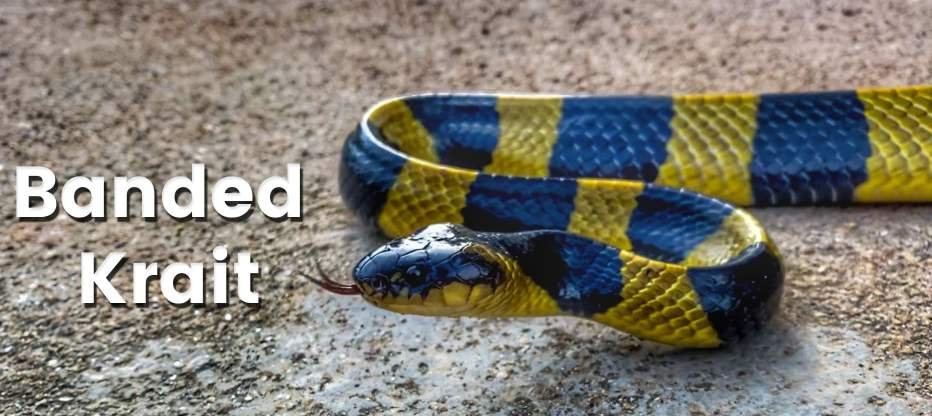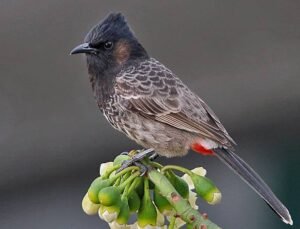Banded Krait Snake All Information
Introduction to Banded Krait Snake
The Banded Krait (Bungarus fasciatus) is one of Asia’s most fascinating and visually striking snakes. Known for its distinct black and yellow bands, this species stands out not just for its appearance but also for its potent venom. Found across South and Southeast Asia, the Banded Krait is a highly venomous snake, yet it’s generally shy and prefers to avoid human interaction. Despite its dangerous reputation, this snake plays an essential role in controlling the populations of other snakes and small animals within its ecosystem. Its presence is a reminder of the delicate balance in nature, where even the most feared creatures have their part to play.

Species Profile: Banded Krait Snake
| Feature | Details |
|---|---|
| Snake Name | Banded Krait |
| Scientific Name | Bungarus fasciatus |
| Regional Names | Hindi: सांखनी (Sankhni) or शंखिनी (Shankhini) Marathi: मनियार (Maniyar) or मण्यार (Manyar) Tamil: கட்டு விரியன் (Kattu Viriyan) or சங்கு விரியன் (Sangu Viriyan) Telugu: గాటు పాము (Gatu Pamu) or పెట్టెలు పాము (Pettelu Pamu) Malayalam: വെളിവിരിയൻ (Veli Viriyan) Kannada: ಕಟ್ಟು ಹಾವು (Kattu Havu) Assamese: শঙ্খিনী (Sankhini) or শংকটাহ (Sonkatah) Bengali: শঙ্খমুটি (Sankhamuti) or শঙ্খমুরি (Sankhamuri) Odia: ଶଂଖମୁରି (Sankhamuri) |
| Physical Description | Alternating black and yellow bands; triangular body cross-section; head slightly broader than neck. |
| Habitat | Forests, grasslands, agricultural fields, and near water bodies. |
| Diet | Primarily other snakes, lizards, and small mammals. |
| Behavior | Nocturnal, shy, generally avoids human contact. |
| Venomous or Non-Venomous | Venomous |
| Venom Type | Neurotoxic |
| Venom Effects on Prey | Causes paralysis by disrupting the nervous system. |
| Venom Effects on Humans | Can lead to respiratory failure, paralysis, and potentially death if untreated. |
| Common or Rare Species | Common in its habitat range but rarely seen due to its secretive nature. |
| Life Span | Approximately 10-12 years in the wild. |
| Mating & Reproduction | Lays eggs, usually during the rainy season; females may lay up to 10-15 eggs per clutch. |
Introduction to Snakes: Banded Krait Snake
Snakes, including the Banded Krait, are remarkable creatures with unique physical characteristics and a significant role in the ecosystem. The Banded Krait is easily identifiable due to its bold coloration, which serves as a warning to potential predators. Its anatomy, with a triangular body cross-section and a head slightly broader than the neck, is designed for stealth and efficient hunting. Snakes like the Banded Krait play a critical role in maintaining the balance of their ecosystems by controlling populations of other animals, such as rodents and other snakes. Despite their importance, snakes are often misunderstood and feared, largely due to myths and misconceptions. Many people believe that all snakes are aggressive and dangerous to humans, but in reality, most snakes, including the Banded Krait, are shy and prefer to avoid contact with humans. Understanding and respecting these creatures can help reduce unnecessary fear and promote coexistence.
Habitat and Distribution of Banded Krait Snake
The Banded Krait is a versatile species that can thrive in various habitats, including forests, grasslands, agricultural fields, and areas near water bodies like rivers and ponds. This adaptability allows it to survive in a wide geographical range, from India and Bangladesh to Myanmar, Thailand, and Malaysia. The Banded Krait prefers environments that offer plenty of cover, such as dense vegetation or debris, where it can hide during the day and emerge at night to hunt. Its distribution across different countries and habitats demonstrates the species’ ability to adapt to various environmental conditions, although it is more commonly encountered during the rainy season when prey is abundant.
| Aspect | Details |
|---|---|
| Habitats | Forests, grasslands, wetlands, agricultural areas, near water bodies. |
| Geographical Distribution | India, Bangladesh, Myanmar, Thailand, Malaysia, and other parts of Southeast Asia. |
Snake Behavior: Banded Krait Snake
Banded Kraits are nocturnal creatures, meaning they are most active during the night when they hunt for prey. Their diet mainly consists of other snakes, including venomous species, making them specialized predators. They also feed on lizards and small mammals. The Banded Krait’s behavior is characterized by its shyness and preference for avoiding human contact. When threatened, it may attempt to flee rather than attack. During the mating season, which usually occurs in the rainy months, females lay eggs in secluded spots like burrows or under debris. The clutch size ranges from 10 to 15 eggs, which incubate for about two months before hatching. In terms of defense, the Banded Krait relies on its potent venom, which can cause paralysis in prey, and its distinctive coloration, which warns potential predators of its toxicity.
First Aid and Medical Treatment for Banded Krait Bites
If bitten by a Banded Krait, immediate first aid and medical attention are crucial. Immobilize the affected limb and keep the victim calm to slow the spread of venom. Do not apply a tourniquet or attempt to suck out the venom, as these methods are ineffective and potentially harmful. The primary treatment involves administering antivenom and providing supportive care to manage symptoms, especially respiratory issues that may arise due to the neurotoxic nature of the venom. It is essential to seek medical help as soon as possible, as untreated bites can be fatal.
Global Impact of Banded Krait Bites
While Banded Krait bites are rare due to the snake’s reclusive nature, they can have severe consequences, particularly in rural areas with limited access to medical care. The impact of such bites can be devastating, leading to long-term disability or even death if not treated promptly. Public education and awareness about this species, its behavior, and the appropriate first aid measures can help reduce the number of fatalities and improve outcomes for bite victims.
If You Encounter a Banded Krait on Your Property
- Remain Calm and Assess the Situation: Do not panic; King Cobras usually avoid confrontation with humans.
- Ensure Safety: Ensure that children and pets are kept away from the area where the snake was spotted.
- Identify the Snake (If Possible): If it’s safe, try to observe the snake from a distance to identify it, but do not approach it.
- Contact Professional Help: Call local wildlife authorities or a snake rescue expert to handle the situation.
- Prevent Future Encounters: Seal potential entry points in your home, keep your yard clear of debris, and avoid leaving food sources that might attract snakes.
- Educate Yourself and Others: Learn about local snake species and share information on how to coexist safely with them.
Tips for Snake Enthusiasts
- How to Safely Observe Snakes in the Wild: Always maintain a safe distance and avoid disturbing the snake. Use binoculars for a closer view without encroaching on its space.
- Tips for Aspiring Herpetologists: Start by studying local snake species and their habitats. Participate in fieldwork and consider pursuing a degree in biology or herpetology to deepen your knowledge.
Interesting Facts About Banded Krait Snake
- Silent Hunter: The Banded Krait is known for its silent hunting style. It relies on its keen sense of smell and night vision to locate prey, often catching its victims off guard.
- Mimicry Behavior: While the Banded Krait’s coloration is a warning, it also practices mimicry by resembling other less venomous species, which can confuse predators.
- Egg-Laying Process: Female Banded Kraits show a unique level of care for their eggs, often selecting well-hidden locations that provide optimal conditions for incubation.
- Rarely Bites Humans: Despite its potent venom, the Banded Krait rarely bites humans. It is more likely to flee than fight, making actual encounters with humans uncommon.
- Evolutionary Success: The Banded Krait’s ability to thrive in various habitats, from forests to agricultural fields, highlights its evolutionary adaptability, ensuring its survival across a wide range of environments.
Frequently Asked Questions (FAQs)
1. What is a Banded Krait?
The Banded Krait (Bungarus fasciatus) is a highly venomous snake found in South and Southeast Asia. It is easily recognizable by its distinctive black and yellow bands that run across its body.
2. Where can Banded Kraits be found?
Banded Kraits are typically found in a variety of habitats, including forests, grasslands, and near water bodies. They are commonly spotted in countries like India, Bangladesh, Thailand, and Indonesia.
3. Are Banded Kraits dangerous to humans?
Yes, Banded Kraits are venomous and can be dangerous to humans. Their venom is neurotoxic, which means it can affect the nervous system, potentially leading to severe symptoms or even death if not treated promptly.
4. What should I do if I encounter a Banded Krait?
If you encounter a Banded Krait, it’s important to stay calm and avoid disturbing the snake. Slowly back away and give it space to move away. Avoid any attempt to handle or harm the snake.
5. What is the diet of a Banded Krait?
Banded Kraits primarily feed on other snakes, including both venomous and non-venomous species. They also eat small mammals, frogs, and fish.
6. How does the Banded Krait reproduce?
Banded Kraits are oviparous, meaning they lay eggs. Females typically lay 8-12 eggs, which hatch after an incubation period of around 60 days. The hatchlings are fully independent and venomous from birth.
7. What is the lifespan of a Banded Krait?
In the wild, Banded Kraits typically live for around 10-15 years, although this can vary depending on environmental conditions and threats from predators.
8. How can I protect myself from snake bites?
To avoid snake bites, be cautious when walking in areas where snakes are common, such as forests or tall grass. Wear protective clothing, such as boots and long pants, and be mindful of where you step. If bitten, seek medical attention immediately.
9. Can Banded Kraits be kept as pets?
Banded Kraits are not suitable as pets due to their venomous nature and specific care requirements. They are best appreciated in the wild or in controlled environments such as zoos.
10. How can I learn more about snakes?
You can learn more about snakes by exploring reliable websites, reading books on herpetology, or watching documentaries and videos. Check out our Related Information section for more resources and educational content!
Related Information
| Topic | Link |
|---|---|
| History of Snakes: Evolution, Habitats, and Survival | Click here |
| The Big Four Snakes of India | Click here |
| What Are Reptiles? | Click here |
| Cobra Snake: All Information | Click here |
| Russell’s Viper | Click here |
| Common Krait: All Information | Click here |
| Saw-Scaled Viper: All Information | Click here |
| King Cobra: All Information | Click here |
| Watch Snake Videos on YouTube | Click here |


